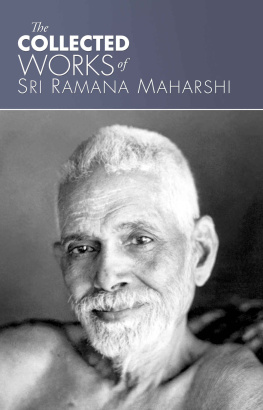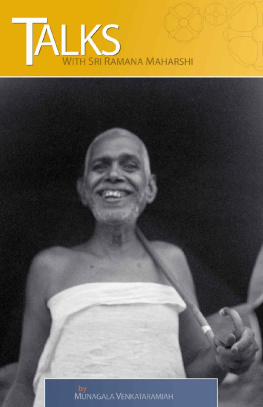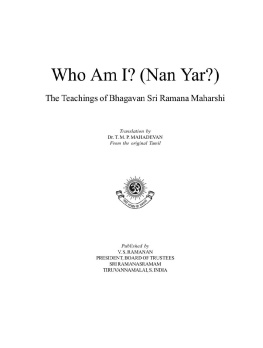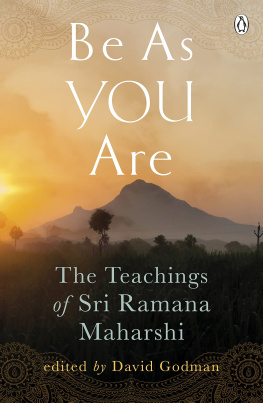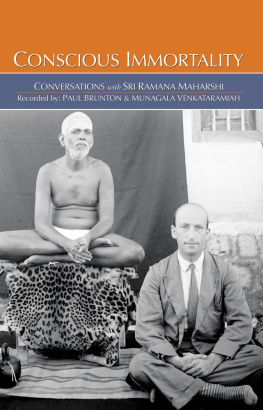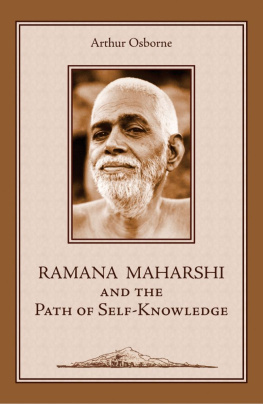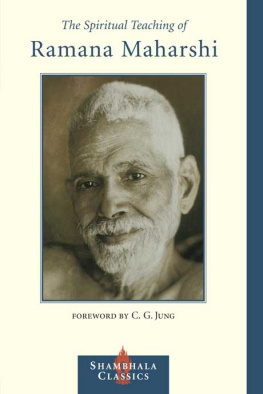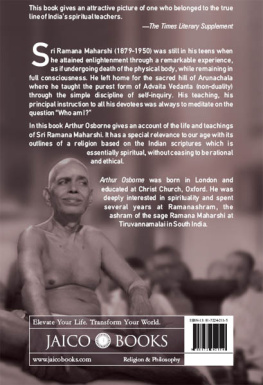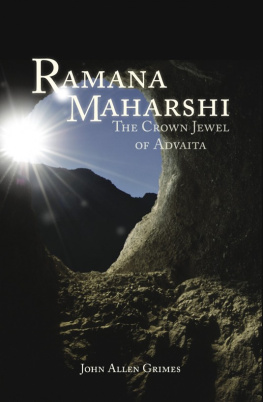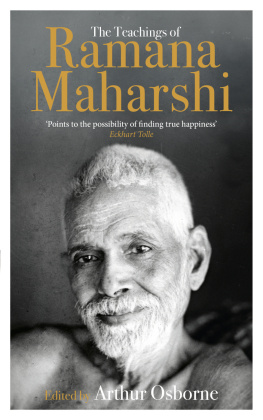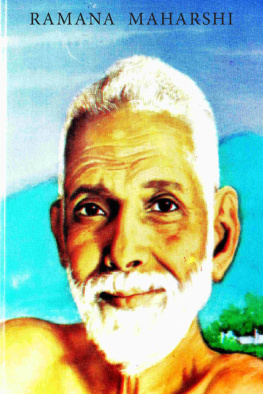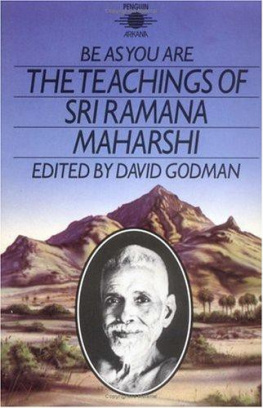Ramana Maharshi - The Collected Works of Sri Ramana Maharshi
Here you can read online Ramana Maharshi - The Collected Works of Sri Ramana Maharshi full text of the book (entire story) in english for free. Download pdf and epub, get meaning, cover and reviews about this ebook. year: 2013, publisher: Sri Ramanasramam, genre: Science. Description of the work, (preface) as well as reviews are available. Best literature library LitArk.com created for fans of good reading and offers a wide selection of genres:
Romance novel
Science fiction
Adventure
Detective
Science
History
Home and family
Prose
Art
Politics
Computer
Non-fiction
Religion
Business
Children
Humor
Choose a favorite category and find really read worthwhile books. Enjoy immersion in the world of imagination, feel the emotions of the characters or learn something new for yourself, make an fascinating discovery.
- Book:The Collected Works of Sri Ramana Maharshi
- Author:
- Publisher:Sri Ramanasramam
- Genre:
- Year:2013
- Rating:4 / 5
- Favourites:Add to favourites
- Your mark:
- 80
- 1
- 2
- 3
- 4
- 5
The Collected Works of Sri Ramana Maharshi: summary, description and annotation
We offer to read an annotation, description, summary or preface (depends on what the author of the book "The Collected Works of Sri Ramana Maharshi" wrote himself). If you haven't found the necessary information about the book — write in the comments, we will try to find it.
The Collected Works of Sri Ramana Maharshi — read online for free the complete book (whole text) full work
Below is the text of the book, divided by pages. System saving the place of the last page read, allows you to conveniently read the book "The Collected Works of Sri Ramana Maharshi" online for free, without having to search again every time where you left off. Put a bookmark, and you can go to the page where you finished reading at any time.
Font size:
Interval:
Bookmark:
THE COLLECTED WORKS
OF
SRI RAMANA MAHARSHI
Sri Ramanasramam
Tiruvannamalai
Electronic Copy
Published by
V.S. Ramanan
President
Sri Ramanasramam
Tiruvannamalai 606 603
Tamil Nadu, INDIA
Phones: 91-4175-237292/237200
email: ashram@sriramanamaharshi.org
web: www.sriramanamaharshi.org
Table of Contents
Publishers Note
Editions prior to the sixth edition of this book contain the text (introduction and translations from Tamil) of Arthur Osbornes original version.
After thoughtful consideration, beginning with the sixth edition, some of the translations were replaced by those of other eminent devotees, like Prof. K. Swaminathans, whose scholarship and devotion have endowed them with insight into the subtleties of the Tamil language. However, the bulk of the translations still remain Arthur Osbornes.
In the previous edition, Dr. H. Ramamurthys translation of Sarvajnanottaram was incorporated along with an Appendix, containing a translation of Sri T. K. Sundaresa Iyers Preface to the Tamil original ( Sri Ramana Nool Thirattu ) of Collected Works .
In this ninth edition, besides some general corrections, two works translated by Sri Bhagavan have been included. They are Na Karmana, and The Heart and Brain. We have also added more information regarding the genesis of certain verses that the Maharshi wrote or translated.
Table of Contents
PART ONE: ORIGINAL WORKS
PROSE
POEMS
PART TWO: ADAPTATIONS AND TRANSLATIONS
Preface
W hen the Maharshi, Bhagavan Sri Ramana, realized the Self, he was a lad in his seventeenth year, belonging to a middle-class brahmin family of South India. He was still going to high school and had undergone no spiritual training and learnt nothing of spiritual philosophy. Normally some study is needed, followed by long and arduous training, often lasting a whole lifetime, more often still incomplete at the end of a lifetime. As the sages say, it depends on the spiritual maturity of a person. It can be compared to a pilgrimage, and a days journey on it to a lifetime; a persons attaining the goal, or how near he comes to it, will depend partly on the energy with which he presses forward and partly on the distance from it at which he wakes up and begins his days journey. Only in the rarest cases is it possible, as with the Maharshi, to take a single step and the goal is reached.
To say that the Maharshi realized the Self does not mean that he understood any new doctrine or theory or achieved any higher state or miraculous powers, but that the I who understands or does not understand doctrine and who possesses or does not possess powers, became consciously identical with the Atman , the universal Self or Spirit. The Maharshi himself has described in simple, picturesque language how this happened.
It was about six weeks before I left Madura for good that the great change in my life took place. It was quite sudden. I was sitting alone in a room on the first floor of my uncles house. I seldom had any sickness, and on that day there was nothing wrong with my health, but a sudden violent fear of death overtook me. There was nothing in my state of health to account for it, and I did not try to account for it or to find out whether there was any reason for the fear. I just felt I am going to die and began thinking what to do about it. It did not occur to me to consult a doctor or my elders or friends; I felt that I had to solve the problem myself, there and then.The shock of the fear of death drove my mind inwards and I said to myself mentally, without actually framing the words: Now death has come; what does it mean? What is it that is dying? This body dies. And I at once dramatized the occurrence of death. I lay with my limbs stretched out stiff, as though rigor mortis had set in, and imitated a corpse so as to give greater reality to the enquiry. I held my breath and kept my lips tightly closed so that no sound could escape, so that neither the word I nor any other word could be uttered. Well then, I said to myself, this body is dead. It will be carried stiff to the burning ground and there burnt and reduced to ashes. But with the death of this body am I dead? Is the body I? It is silent and inert but I feel the full force of my personality and even the voice of the I within me, apart from it. So I am Spirit transcending the body. The body dies but the Spirit transcending it cannot be touched by death. That means I am the deathless Spirit. All this was not dull thought; it flashed through me vividly as living truth which I perceived directly, almost without thought-process. I was something very real, the only real thing about my present state, and all the conscious activity connected with my body was centred on that I. From that moment onwards the I or Self, focused attention on itself by a powerful fascination. Fear of death had vanished once and for all. Absorption in the Self continued unbroken from that time on. Other thoughts might come and go like the various notes of music, but the I continued like the fundamental sruti note that underlies and blends with all the other notes. Whether the body was engaged in talking, reading, or anything else, I was still centred on I. Previous to that crisis I had no clear perception of my Self and was not consciously attracted to it. I felt no perceptible or direct interest in it, much less any inclination to dwell permanently in it.
Such an experience of identity does not always, or even normally, result in liberation. It comes to a seeker but the inherent tendencies of the ego cloud it over again. Thenceforward he has the memory, the indubitable certainty, of the true state, but he does not live in it permanently. He has to strive to purify the mind and attain complete submission so that there are no tendencies to pull him back again to the illusion of limited separative being. However, the Self-oblivious ego, even when once made aware of the Self, does not get liberation, that is, Self-realization, on account of the obstruction of accumulated mental tendencies. It frequently confuses the body with the Self, forgetting that it is itself, in truth, the Self. The miracle was that in the Maharshis case there was no clouding over, no relapse into ignorance; he remained from then on in constant awareness of identity with the one Self.
For a few weeks after this awakening he remained with his family, leading outwardly the life of a schoolboy, although all outer values had lost their meaning for him. He no longer cared what he ate, accepting with like indifference whatever was offered. He no longer stood up for his rights or interested himself in boyish activities. In so far as it was possible he conformed to the conditions of life and concealed his new state of consciousness, but his elders saw his lack of interest in learning and all worldly activities, and resented it.
There are many holy places in India, representing different modes of spirituality and different types of paths. The holy hill of Arunachala with the town of Tiruvannamalai at its foot, is supreme among them, in that it is the centre of the direct path of Self-enquiry guided by the silent influence of the Guru upon the Heart of the devotee, the secret and sacred Heart-centre of Siva, wherein He always abides as a Siddha (great one).
It is the seat of Siva who, identified as Dakshinamurti, teaches in silence as was exemplified in the life of Bhagavan.
It is the centre and the path where physical contact with the Guru is not necessary, but the silent teaching speaks direct to the Heart. Even before his Realization it had thrilled the Maharshi and drawn him like a magnet.
Hearken; It stands as an insentient
Now, seeing that his elders resented his living like a sadhu while enjoying the benefits of home life, he secretly left home and went as a sadhu to Tiruvannamalai. He never left there again. He remained for more than fifty years as Dakshinamurti, teaching the path of Self-enquiry to all who came, from India and abroad, from East and West. An ashram grew up around him. His name of Venkataraman was shortened to Ramana, and he was also called the Maharshi, that is the Maha Rishi or great sage, a title traditionally given to one who inaugurates a new spiritual path. However, his devotees mostly spoke of him as Bhagavan. In speaking to him they also addressed him in the third person as Bhagavan. Self-realization means constant conscious awareness of identity with Atman , the Absolute, the Spirit, the Self of all; it is the state which Christ expressed when he said: I and my Father are One. This is a very rare thing. Such a one is habitually addressed as Bhagavan, which is a word meaning God.
Next pageFont size:
Interval:
Bookmark:
Similar books «The Collected Works of Sri Ramana Maharshi»
Look at similar books to The Collected Works of Sri Ramana Maharshi. We have selected literature similar in name and meaning in the hope of providing readers with more options to find new, interesting, not yet read works.
Discussion, reviews of the book The Collected Works of Sri Ramana Maharshi and just readers' own opinions. Leave your comments, write what you think about the work, its meaning or the main characters. Specify what exactly you liked and what you didn't like, and why you think so.

